LATEST
NEWS:
March
2016

Sea
Hare
Photograph
by Paula Lightfoot
Huge
numbers of the large Sea Hares, Aplysia
punctata, were discovered on the shore
at Runswick
Bay, North Yorkshire "They are
all over the shore, not just in rockpools, we
had to be very careful not to step on them!"
They
have also been found at Filey Brigg, Selwick Bay, Flamborough Head, South
Bay Scarborough, Selwicks, South Landing and Boggle Hole, all on the Yorkshire
coast. The first ones were found in November
2015.
The
interesting and newsworthy aspect of this prevalence is that occurrences
in these vast numbers are are highly variable from year to year.
Only in rare years are the spawning aggregations seen in such enormous
numbers.
BMLSS
Aplysia
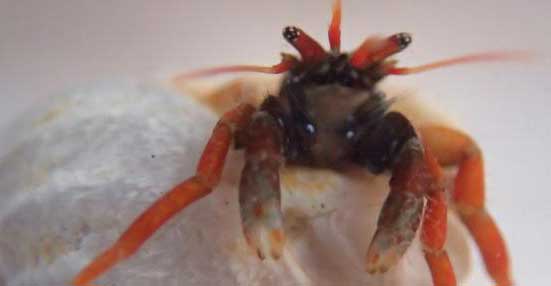 12
March 2016
12
March 2016
A
tiny and brightly colourful hermit crab
was discovered by volunteers on a Cornwall
Wildlife Trust ‘Shoresearch’
survey at a Castle
Beach, Falmouth.
The tiny hermit crab measuring only six millimetres
in length hasn't been recorded in Cornish waters since 1985.
The species which doesn't have a common name is only known as Clibanarius
erythropus (from the Latin meaning
soldier, clad in mail with red legs!)
This is a southern species which is common in Channel Islands and along
the French coast.
BMLSS
Hermit Crabs in Devon
7 March
2016
A
Bluemouth
Rockfish, Helicolenus dactylopterus,
was captured in a creel
in the Minch, western
Scotland. This deep water fish is common off Norway but not so often caught
in shallow water.
Previous
Report
2
March 2016
A
young male Humpback Whale,
Megaptera
novaengliae,
was washed ashore dead
at Traigh Hamara
at the southern end of the island of Barra
in the Outer Hebrides.
The whale looked like it had perished after becoming entangled in fishing
nets.
BMLSS
Cetacea
A
Loggerhead
Turtle,
Caretta
caretta, was rescued on Vazon
Beach, Guernsey,
Channel Islands. It was accompanied by a Columbus
Crab,
Planes minutus.
BMLSS
Turtles
11
February 2016
A
12 cm long Mantis Shrimp, Rissoides
desmaresti, was washed ashore on the
Kent coast. This is the first known record from Kent. The discovery was
made at Greatstone
on the English Channel coast.
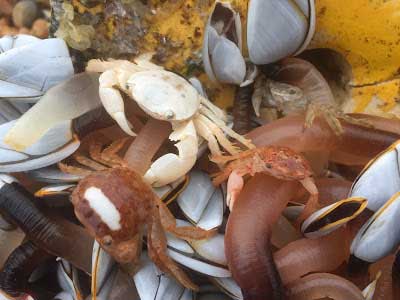 9
February 2016
9
February 2016
The
first tiny Columbus Crabs,
Planes
minutus, ever recorded along the Sussex
coast were discovered by Graham
Lyons on the chalk rocky eastern part
of Brighton Beach
amongst a clump of Goose Barnacles,
Lepas
anatifera, that had floated in after
the storm and found near the Brighton
Marina wall.
5
February 2016
A
Cuvier's
Beaked Whale,
Ziphius
cavirostris, was washed ashore dead at at
St
John's Point, County
Donegal, Ireland.
This
deep water species of dolphin is only rarely seen alive. This specimen
showed the rasping marks of a Sea Lamprey,
Petromyzon
marinus attachment.
4
February 2016

Second
Sperm Whale 2016 at Hunstanton
Photograph
by Eric Y202
The
stranding tragedy reached even further epic proportions with another large
Sperm
Whale,
Physeter
macrocephalus,
that was discovered alive one and a half miles out on the vast sandy flats
between Old Hunstanton
and Holme-next-the-Sea,
Norfolk. The huge whale was noted breathing in
the early morning, but was not expected to survive. The tide
came in but the whale was still unable to escape the suction of the sand
and it finally died about 8:00 pm.

Sperm Whale from Hunstanton
Cliffs
Photograph
by Paula Sparkes
Previous
Stranding
2
February 2016
Another
Sperm
Whale,
Physeter
macrocephalus, in an advanced state
of decomposition was found stranded on the sandy beach of Hemmes-de-Marck
near Calais, France.
The whale was
about 14 metres long.
1
February 2016
Eight
further young bull Sperm Whales,
Physeter
macrocephalus,
were discovered found stranded dead near the northern town of Friedrichskoog,
Schleswig
Holstein, northern Germany. The young bull whales were around the same
age and size as the animals discovered three weeks ago at various
North Sea spots. They were lying close to each other in the mudflats
of a restricted area of the Wadden
Sea National Park. Two further Sperm
Whales were discovered on 3
February 2016 raising the total recent southern
North Sea strandings to 28 (including the one above).
Since
the 1990s, a
total of 82 Sperm Whales
have been found stranded in the Wadden
Sea in Denmark, the Netherlands and Germany.
January
2016
The
first month of the year was characterised by frequent gales interspersed
with calm weather. The gales blew in the usual debris of seaweeds
and shells on to the strandline,
including unusually high numbers of pelagic animals especially thousands
of clumps of Goose Barnacles,
Lepas
anatifera, attached to floating objects
have been washed ashore all along the south coast from Cornwall to Kent
and on west facing Atlantic shores. Beachcombers have discovered the tiny
Columbus
Crabs,
Planes minutus, amongst
the wrecks. Other wrecks include moribund Loggerhead
Turtles,
Caretta
caretta, Triggerfish,
Balistes
capriscus, and more Barrel
Jellyfish, Rhizostoma octopus.
Clumps
of the poisonous
mineral oil were also washed ashore
in large unsightly amounts on most of the south coast of England.
List
of trans-Atlantic rafting species (Aphotomarine)
BMLSS
Strandlining/Beachcombing
BMLSS
Barnacles
BMLSS
Turtles
BMLSS
Jellyfish
25
January 2016
A
fifth (seventeenth in total) Sperm Whale,
Physeter
macrocephalus,
was discovered washed up dead on the inaccessible coast at Wainfleet,
Lincolnshire.
| Expert
and observations seem to conclude that the original pod of the 17 Sperm
Whales entered the shallower North Sea
from deeper northerly seas and that the complete pod perished in
two weeks.
Click
on the map for the full
illustrated report by Philip Hoare for the Daily Mail.
New
Scientist Report
Once
a Sperm Whale or group of Sperm Whales
has entered the North Sea and continues due south, the animals will reach
progressively shallower waters. The North Sea, and particularly its funnel-shaped
southern sector less than 50 metres deep, is totally unsuitable for Sperm
Whales. Although they must be able to go without
food for quite some time, a prolonged stay in these waters will eventually
prove fatal, if the animals do not find their way out in time.
Historical
Records |
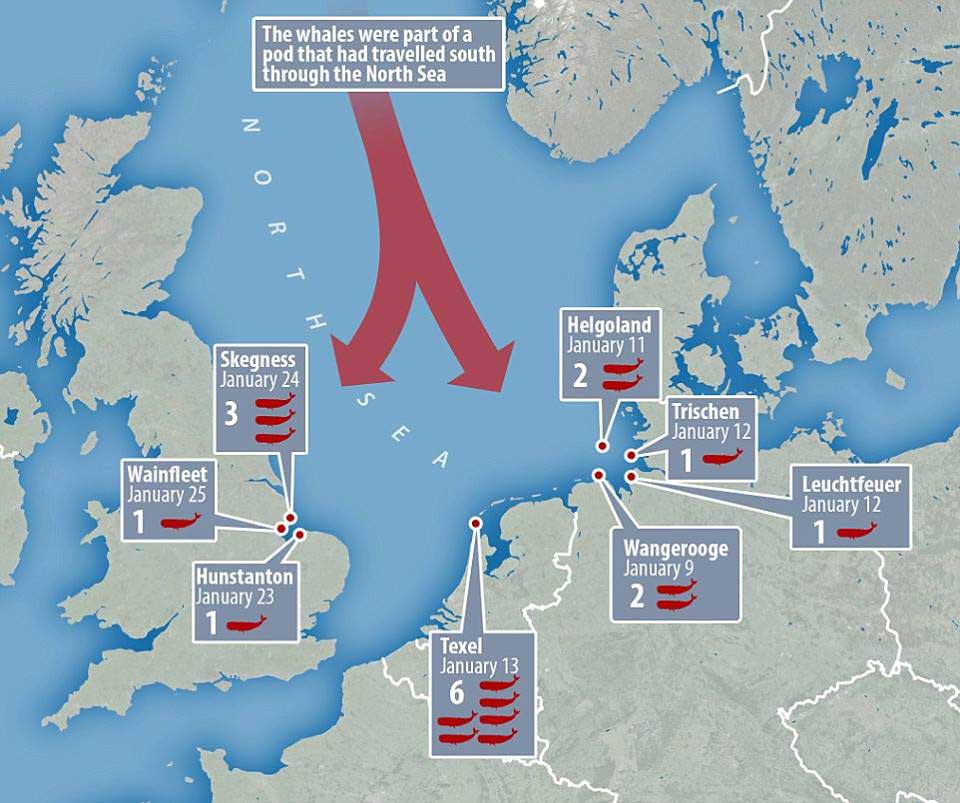 |
Sperm
Whales in the Firth of Forth 2013
24
January 2016

Sperm Whales stranded
at Skegness
Photographs
by Graham G.N. Cummings
Calamitously,
the other three Sperm Whales, Physeter
macrocephalus,
in the pod (see below) were found washed ashore
dead at
Skegness.
Two were stranded together on the sandy beach.
Cetacean
Strandings Investigation Programme (CSIP): UK Strandings
22
January 2016
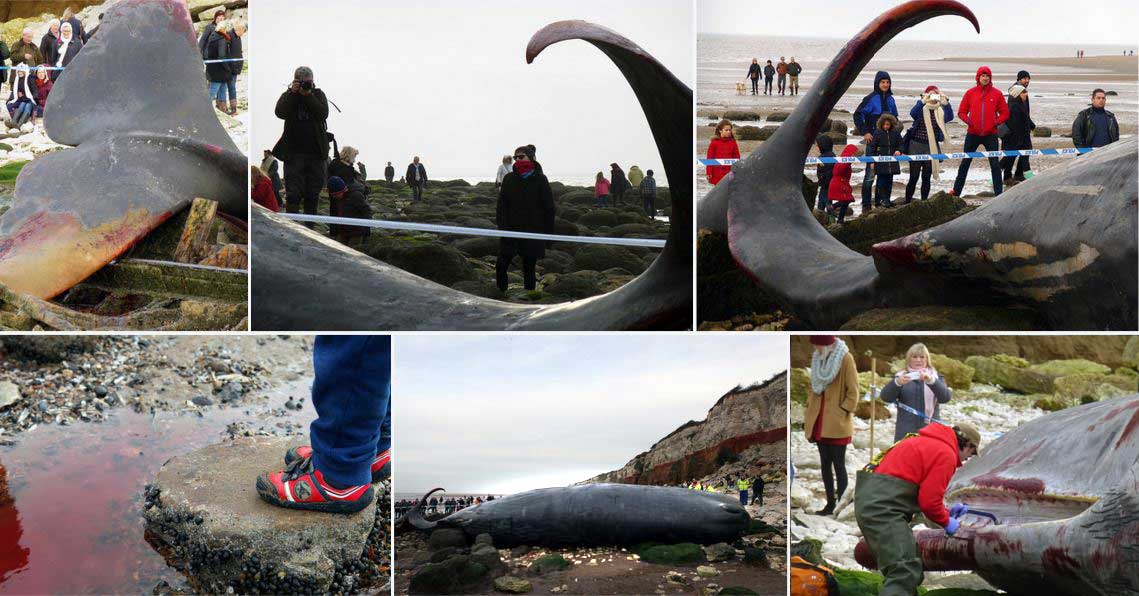
Sperm Whale stranded at
Hunstanton
Photographs
by Bull
of the Bog
Four
Sperm
Whales, Physeter
macrocephalus,
were seen very close inshore under Hunstanton
cliffs, Norfolk at night. Three swam back out into The Wash and one a big
bull got stranded. It was probably already injured it was bleeding heavily
from its tail, as the tide ebbed away so did its
life. The following day a team of vets from Zoological
Society of London (ZSL) raced against the tide to carry out a field
necropsy
and crowds of curious sightseers gathered to view this stranded leviathan.
Previous
(2011) stranding at Hunstanton
15
January 2016
A
Kemp's
Ridley Turtle,
Lepidochelys
kempii,
(national
reference T2016/6) was found dead stranded at Poppit
Beach in Pembrokeshire, Wales. Marine
Environmental Monitoring recovered the body for post-mortem examination.
The turtle was found with a satellite tag glued to its back. Subsequent
investigation by MEM established that the turtle had previously stranded
on the French coastline and been taken in for rehabilitation in La
Rochelle, before being released after being tagged with both a satellite
tag and a PIT (passive integrated transponder) tag. The satellite tracking
had shown the turtle initially moving north, before the signal stopped
transmitting last October. The necropsy of the juvenile female turtle showed
that it had reasonable deposits of fat, but no gross evidence of disease
was noted. Subsequent bacteriological culture of tissues found the pathogenic
bacterium Aeromonas salmonicida
in the bladder and follow up tests are pending.
BMLSS
Turtles
12
January 2016

Five
Sperm
Whales, Physeter
macrocephalus,
beached on the Dutch Wadden
Sea island of Texel
all died overnight as expected. The whales were spotted in difficulty close
to the shore and rescue efforts continued until midnight, without success.
8 January
2016
Two
male Sperm Whales, Physeter
macrocephalus,
washed ashore dead on the island of Wangerooge
in the shallow waters of the German Wadden
Sea. The largest whale measured 13 metres and the smaller whale at
12 metres.
Sperm
Whales are huge whales
that inhabit deep water and are unusual and out of place in the shallow
part of the southern North Sea.
Altogether,
the count of dead Sperm Whales
on the Dutch and German coasts was 12. A fishing
net was discovered in the stomach of one of the dead whales.
5 January
2016
A
Killer
Whale, Orcinus
orca, called "Lulu"
and
a recognised member of the only resident
British
Killer Whales called the "Hebridean
or Western Community" was discovered washed
ashore dead on the Isle of
Tiree, Inner
Hebrides. It was thought that Lulu
become entangled in fishing gear and then drowned.
BMLSS
Cetacea
11
June 2016
Adur World Oceans
Day
.jpg)
Adur
will be one of the UK leaders in presenting the seventeenth environmental
exhibition of World
Oceans Day on Coronation
Green,
Shoreham-by-Sea.
The
British Marine Life Study
Society will present the usual exhibition of
lobsters
and crabs.
The Friends of Shoreham Beach (FOSB)
take an active role with their display of the wonders of Shoreham
Beach. Wildlife writer Steve
Savage presents the whale
and dolphin exhibition.
Exhibitors are available to find the time to answer questions about marine
life.
Other
participants will include Southwick
Camera Club with an exhibition of seascapes and marine life..
World
Oceans Day on facebook
Adur
World Oceans Day on facebook
United
Nations: World Oceans Day
British
Marine Life News 2013
flickr
MARINE
WILDLIFE of the NE ATLANTIC

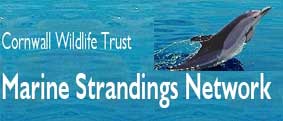
BMLSS
Oil Disasters page



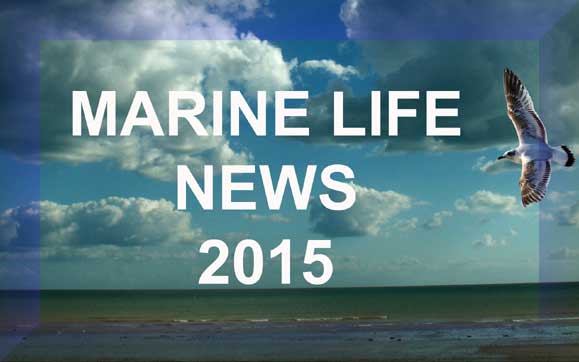
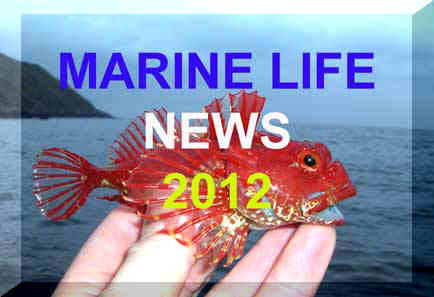















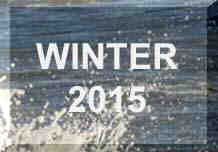
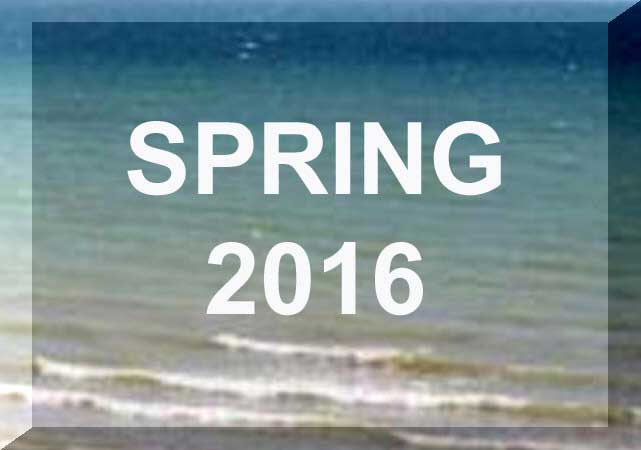
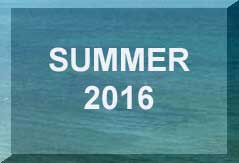

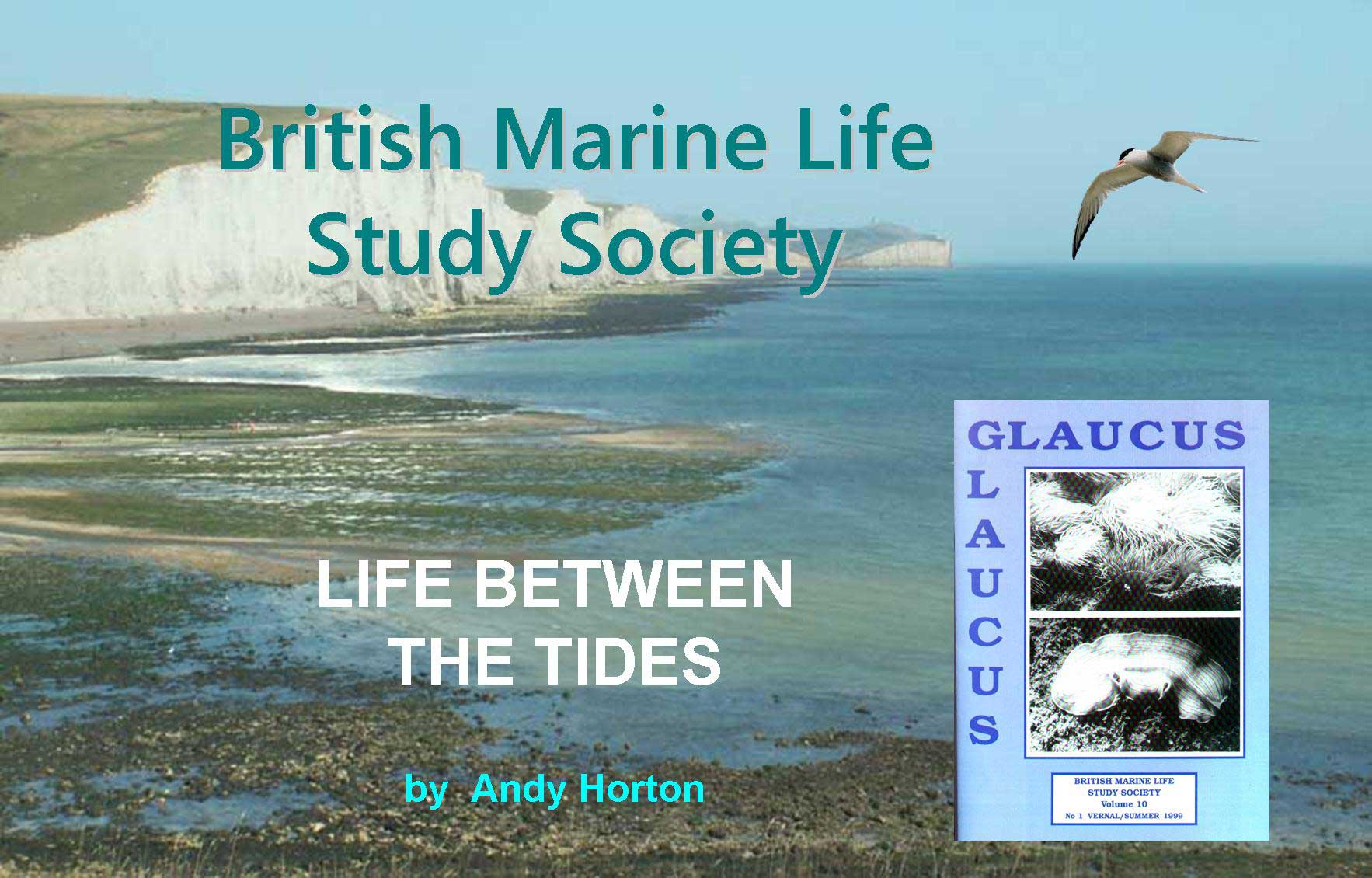

 12
March 2016
12
March 2016






-ST.jpg)




.jpg)


